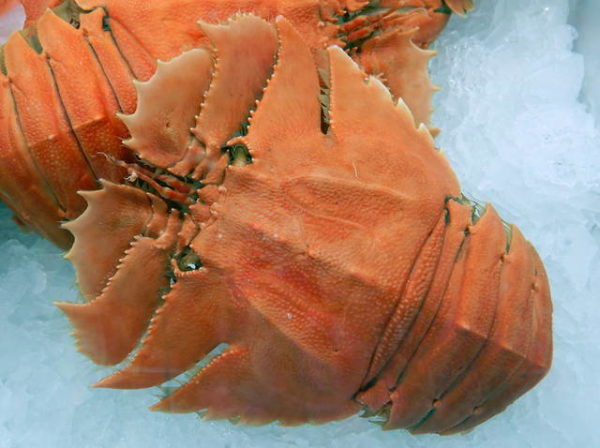Published in the Ocean Watch column, Honolulu Star-Advertiser © Susan Scott
September 9, 2017
Last week when our Sydney taxi driver asked the carload of us where we were from, we shouted in unison, “Bangladesh! France! Guatemala! Hawaii!” We were in Australia attending a wedding, the groom Bangladeshi, the bride French-Guatemalan.
One of the places the French wanted to visit the following week was the Sydney Fish Market, a shore-side facility famous for artful displays of edible marine animals. Many are still alive, the bride told me. You choose something and they cook it for you. Given my interest in marine biology, she was sure I would want to go.
 An Australian slipper lobster known as a Balmain bug. ©2017 Susan Scott
An Australian slipper lobster known as a Balmain bug. ©2017 Susan Scott
Oh, dear. This brought up my dilemma regarding marine life. It feels wrong to eat the animals that give me so much pleasure when I see them alive in their natural environments.
Seeing them suffocating in tiny tanks and twitching on beds of ice makes my stomach hurt. Plus, I’m aware of stock depletion, habitat destruction and the wasteful ways we catch fish.
On the other hand, it feels equally wrong not to eat marine life that someone, whose livelihood depends on fishing, has already caught. And then there are the markets and restaurants whose owners and employees earn their livings by cooking and selling fish.
According to Sylvia Earle, an oceanographer who has spent more than 50 years working to save the world’s oceans, we who have choices should stop eating all marine animals.
I can practically hear the gasps from island residents, where catching and eating fish, lobster, shrimp and crab is part of daily life. But Sylvia isn’t a fanatic. She’s a scientist who knows the data.
Factory ships put out enormous nets and lines 50 or 60 miles long, and bottom trawlers scoop up entire ecosystems. Humans’ ability to kill wildlife has far surpassed the oceans’ ability to keep up. Even more disturbing is that much of what’s caught is thrown out.
Many people think that marine animals’ sole purpose in existing is to feed us. Not so. Their roles in ocean ecosystems far outweigh our need to eat them.
This wedding, where people of several races came together to celebrate the union of two people from different cultures, was a good example of a changing world. With 7 billion people on the planet, and the oceans in trouble, I’m changing, too. I’m not a vegetarian, but more and more I’m choosing to eat plants over animals.
Except for my visit with those special friends at the Sydney Fish Market. I ordered eel because it was already dead. I had recently written about it. (I didn’t like it.)
The bride picked a slipper lobster known as a Balmain bug. When she passed me her plate for a taste, a silver gull swooped down, snatched the entire lobster tail and flew off with it.
Fair enough, I thought. Seabirds don’t have many choices.
Fortunately, we Americans do.